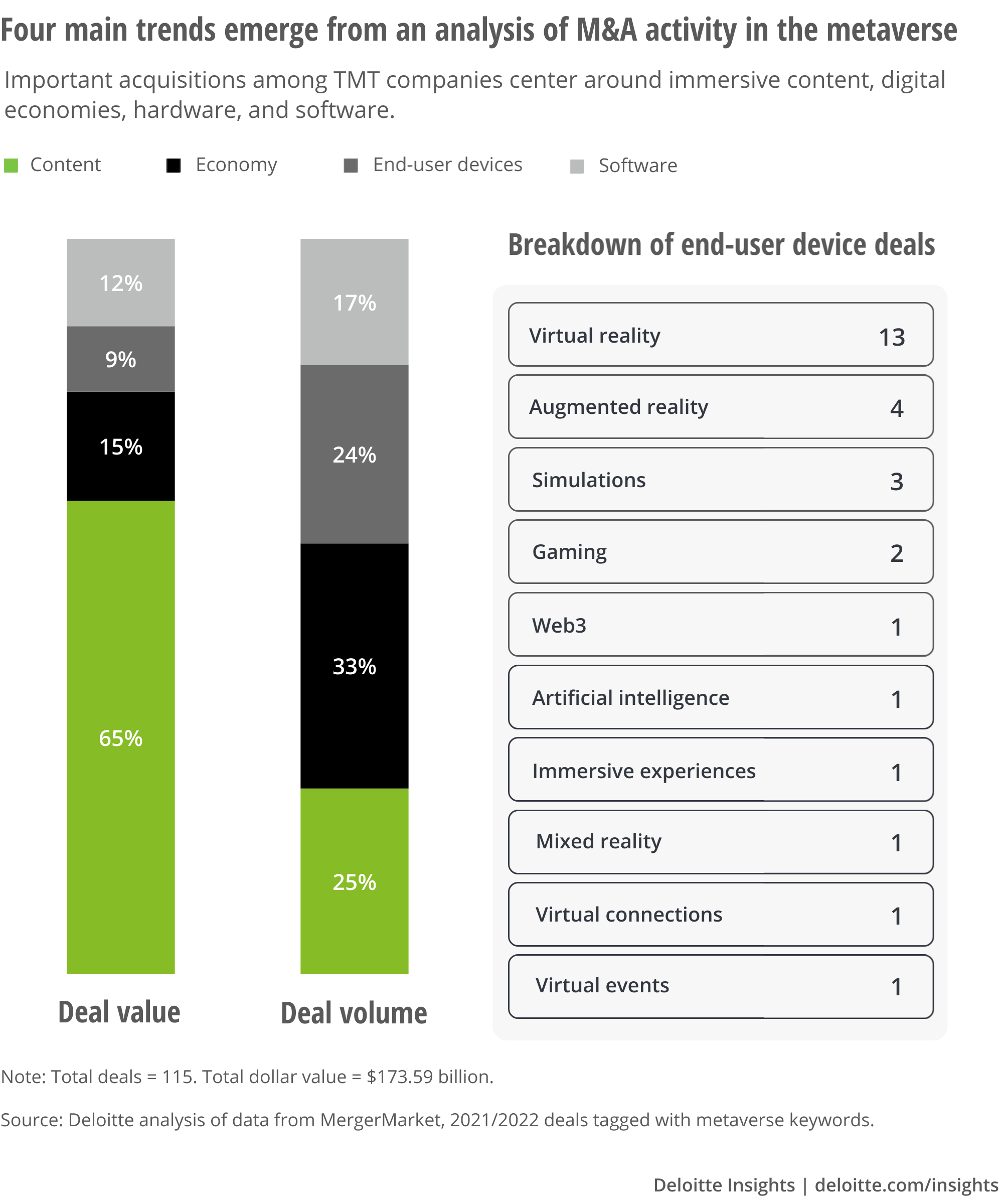Venturing into the metaverse with strategic M&A
TMT companies are focused on four key areas in their quest for metaverse readiness.

Technology, media, and telecommunications (TMT) companies play important roles in building the metaverse. As they stake out positions and plan their offerings, industry players could move to build and buy metaverse-related capabilities like spatial computing, tokenized assets, 3D modeling, AI and machine learning, and augmented-, virtual-, and mixed-reality devices. Companies advancing their metaverse strategies should consider how far their existing technologies and in-house skills will take them on this journey, and where targeted acquisitions may offer the fastest and most effective growth strategy.
In the current hype cycle, almost any deal that involves high-speed networking or cloud or edge computing, for example, may be categorized broadly as “metaverse.” Our analysis found that, over the past 24 months, 115 transactions involved a technology or solution that could directly enable the metaverse.1 From offering next-generation entertainment experiences to providing the technologies that power it all, it is no surprise that TMT companies drove three-quarters of these deals. The metaverse landscape is fragmented, however, and still lacks any single dominant player. This could create an opportunity for companies to use mergers and acquisitions (M&A) to purchase critical components and fill strategic gaps.
To identify trends in metaverse M&A activity, we can draw useful “market boundaries” or categories around content, user devices, software, and economy. Three findings emerged from this view of the transactions:
Content remains king: Over the past 23 months, content-related transactions accounted for the largest deals by value and average deal size. Although bolstered by a US$69B gaming deal, content will likely remain at the forefront of metaverse-related deal activity.2 This could be especially true for gaming studios and technology providers that may already be closest to delivering metaverse experiences. Indeed, gaming M&A will likely continue growing.3
User devices may not be a key differentiator: While some deals may be looking at key enabling technologies like optics for AR glasses, overall deal value for user devices tends to be low. The landscape of devices geared towards metaverse experiences may still be fragmented and can be difficult to navigate due to information asymmetry. To enable more widespread adoption, devices may need to align around interoperability standards. Recently, big names in software technology have been forming large consortiums to assemble a standards group for metaverse tech.4 Practically, this means that companies with more mature hardware may seek to acquire emerging device and component manufacturers to accelerate standards compliance. With growing interest in bringing metaverse capabilities to existing devices like laptops and smartphones, novel hardware may focus more on supporting premium experiences and specialized enterprise or industrial use cases.
Financial firms are the biggest movers: When considering the volume of deals, financial buyers have been the early movers, likely given their access to capital and appetite for risk. Over 40% of deals that we analyzed occurred through at least one financial buyer or by groups of smaller private equity shops. In the near term, we could expect cash-rich financial investors and consortium participants to continue gaining familiarity and comfort with the metaverse. However, this may put pressure on other potential buyers hoping to establish early competitive advantage.
What TMT companies should consider
As TMT companies look to develop metaverse capabilities, they should consider all aspects of the value chain, from hardware to software to virtual and physical services. Media and entertainment may look to bring their existing content into metaverse experiences, or to buy content libraries from others. In addition, these companies might need to partner or buy the technology required to deliver and scale those experiences. To help foster broader adoption, hardware companies developing user devices could consider interoperability by exploring partnership strategies. Hardware companies may also want to consider road-map acceleration through acquisitions or partnerships with niche or pure-play technology companies. Software companies and gaming studios can seek innovative capabilities that might enable content providers to bring their intellectual property (IP) into shared immersive experiences.
All these opportunities underscore the need for thoughtful M&A strategies. As TMT companies think about building their metaverse capabilities, they should consider the following:
- What is the vision for our role in the metaverse economy? Is it in core infrastructure and services, enterprise enablement, or consumer experiences?
- Where do our current strengths lie and where do they fall short? What capabilities are needed to support a metaverse strategy?
- Does our organization have the talent needed to execute on its metaverse aspirations?
- What technical abilities or IP will we need to bring its metaverse vision to life?
Acquiring a capability may offer an expedited path to knowledge, experience, and captured value. With an informed M&A strategy, companies could shape future markets and offerings and help to accelerate metaverse adoption.